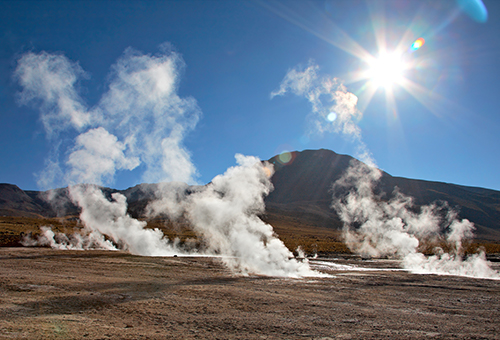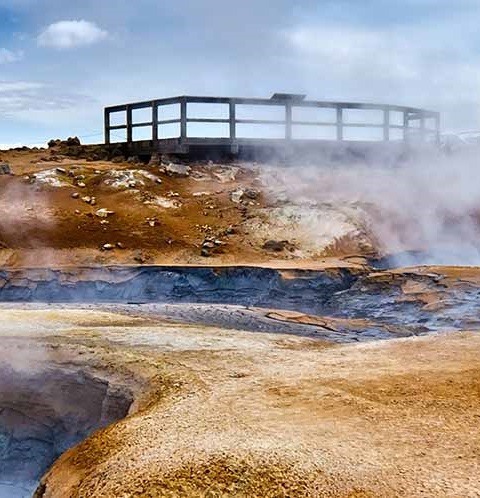Using the Earth’s underground temperature to produce heat or electricity: that is the principle behind geothermal energy. Less well known than solar and wind energy, it is nevertheless the third most widely used renewable energy in France. This is how it works.
- What is geothermal energy?
- How does geothermal technology work?
- The advantages of geothermal energy
- Constraints and key concerns
- What is the current status of geothermal energy?

What is geothermal energy?
The word geothermal comes from the Greek gê (meaning earth) and thermos (meaning hot). Geothermal technology is based on techniques making it possible to recover the heat naturally present underground and in groundwater (aquifers) and use it as a source of energy. This heat comes either from the phenomena responsible for the formation of the planet, billions of years ago, or is the result of natural radioactivity.
|
Depth = heat! |
How does geothermal technology work?
Depending on the temperature of the underground environment, techniques for recovering and using the heat vary. A distinction is generally made between two types of geothermal energy.
Low-energy geothermal (temperatures <90°C)
This is the easiest to access, in particular for private individuals, since it simply requires a heat pump. It is generally used as a supplementary energy source to supply heating for buildings.
-
Ultra-low-temperature geothermal energy (<30°C): this refers to heat taken from the ground or underground water at depths of less than 200 m. The temperature is quite low, but it is high enough to allow heat to be recovered for heating and air conditioning purposes.
-
Low-temperature geothermal energy (from 30 to 90°C): fields are located in deep aquifers at depths ranging from a few hundred meters to 2,500 m. The temperature, while being too low to produce electricity, is high enough to generate heat by direct thermal exchange. This solution is reserved for large-sized buildings.
The low-energy solutions are generally used to heat buildings.
High-energy geothermal (temperatures <90°C)
The higher temperatures make it possible to recover more energy and produce electricity.
-
High-temperature geothermal energy (from 90 to 150°C): at this temperature, heat is captured in the form of steam or hot water as at the Bouillante power plant in Guadeloupe. Reservoirs are either targeted zones at depths of under 1,000 m, or sedimentary basins at depths of between 2,000 and 4,000 m. Electricity production requires a heat-carrying fluid: geothermal water transfers its heat to another liquid, which vaporizes at low temperature and activates a turbine producing electricity.
-
Ultra-high-temperature geothermal energy (>150°C): this is associated with fractured reservoirs, i.e., underground zones presenting natural faults, such as that exploited in the Rittershoffen power plant, in Alsace, north-east France. Drilling operations are conducted (generally at depths of more than 1,500 m) to circulate the water present in these fractures and bring it to the surface, taking advantage of the permeability and natural flows present in the fault network. It is also possible to inject water under pressure to create steam. Once at the surface, geothermal water is converted to heat or electricity, via a plant operating with an Organic Rankine Cycle (process to produce electricity from heat using an organic fluid).
The advantages of geothermal energy
There are a number of advantages associated with geothermal energy:
- it is a clean energy source, which does not generate any waste. The only electricity required is for the purposes of operating the heat and/or hydraulic pumps. The quantity of CO2 emitted by a geothermal power plant is thus 10 times lower on average than that of a power plant operating using natural gas;
- this energy is regularly available, since it does not depend on atmospheric conditions (sun, rain, wind), unlike solar and wind energy, for example;
- it has no impact on the landscape: once completed, geothermal drilling operations are not visible;
- it can be easily exploited relatively close to the surface, making it accessible to private individuals;
- it is renewable… provided reasonable operating conditions are respected, of course.
Constraints and key concerns
As with any energy sources exploiting natural resources, geothermal energy depends on local conditions, in this case, the geology of the underground environment. Volcanic zones are therefore the most suitable for high-energy geothermal solutions.
The heat generated from geothermal energy must be used locally, since transport over long distances generates thermal losses. This problem does not arise for electricity, which is transported via power lines.
It requires significant start-up investment (drilling, heat pump, etc.), which is then offset by a highly competitive price per kilowatt hour.
Lastly, reservoirs may become depleted as they are exploited if groundwater is not given the time to reheat by circulating in the underground environment. It is therefore essential to cap the quantities of heat taken and limit the exploitation of reservoirs over time.
What is the current status of geothermal energy?
Currently, 90 countries around the world use geothermal energy and in some of these countries it accounts for more than 20% of their national production. In France, geothermal energy is the 3rd most widely used renewable energy, behind biomass and hydroelectricity.
Geothermal resources present across mainland France and its overseas territories and regions are extremely rich, but as yet little developed. Thus, only 10% of new homes are equipped with heat pumps (compared with 35% in Switzerland and 90% in Sweden). France’s first geothermal power plant is located in Guadeloupe. A second one, in Alsace, is at the experimental stage.
 Our expertise > Geothermal energy
Our expertise > Geothermal energy





